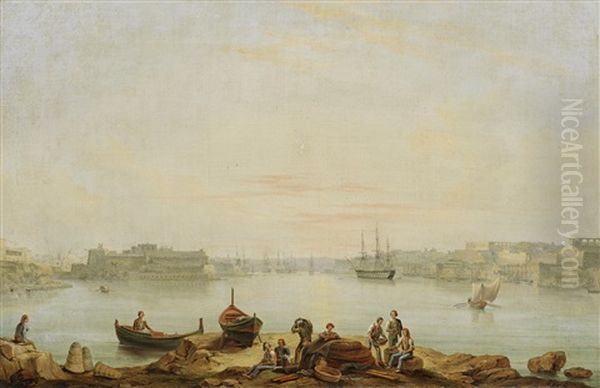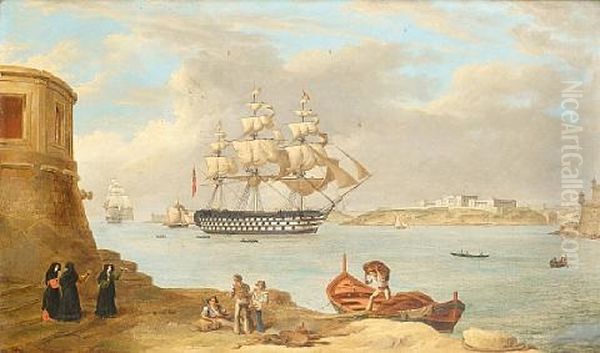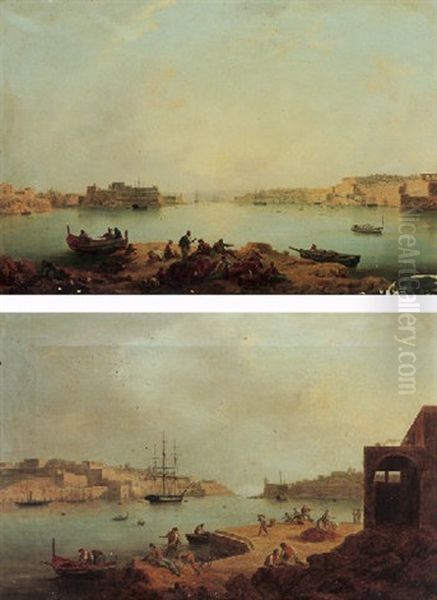Anton Schranz stands as a significant figure in the annals of early 19th-century European art, particularly celebrated for his evocative and detailed depictions of Malta. A German by birth, Schranz found his artistic voice and lasting legacy under the Mediterranean sun, becoming one of the foremost painters of the island's majestic harbours and picturesque landscapes. His work not only captured the visual splendour of Malta but also chronicled a pivotal era of its maritime and colonial history, leaving an indelible mark on the artistic heritage of the region.
Early Life and Germanic Roots
Born in 1769 in Ochsenhausen, a town in Upper Swabia, then part of the Holy Roman Empire, Anton Schranz's early life and artistic training in his homeland are not extensively documented. However, the artistic environment of late 18th-century Germany was rich and varied. Neoclassicism, championed by artists like Anton Raphael Mengs, was a dominant force, emphasizing clarity, order, and idealized forms inspired by antiquity. Simultaneously, the burgeoning Romantic movement, with figures such as Caspar David Friedrich, began to explore emotional depth, individualism, and the sublime power of nature.
While direct influences on Schranz's formative years are speculative, it is plausible that he was exposed to these prevailing artistic currents. The German tradition of meticulous landscape painting and topographical accuracy, seen in the works of artists like Adrian Zingg or later, Carl Blechen, might have also played a role in shaping his eye for detail and his appreciation for the natural world. His eventual specialization in vedute, or highly detailed view paintings, suggests an inclination towards precision and a faithful representation of scenery, a characteristic valued in Germanic art.
The Lure of the Mediterranean: Arrival in Malta

The exact circumstances and timing of Anton Schranz's relocation from Germany to Malta are not precisely known, but he was active on the island by the early 19th century. Malta, with its strategic location, rich history, and stunning natural harbours, had long attracted travellers, military personnel, and artists. By the time Schranz arrived, the island had recently transitioned from the rule of the Knights of St. John to British influence, becoming a Crown Colony in 1813. This period saw an influx of British officials, merchants, and naval presence, creating a new market for art, particularly views of the island.
For an artist like Schranz, Malta offered a wealth of subject matter. The Grand Harbour and Marsamxett Harbour, with their intricate coastlines, formidable fortifications, and bustling maritime activity, were particularly inspiring. The unique golden hue of the Maltese limestone, the clarity of the Mediterranean light, and the dramatic interplay of sea and sky provided an endlessly fascinating canvas. Schranz, like other artists drawn to the Mediterranean, such as the earlier French master Claude Joseph Vernet known for his seascapes, or the Swiss artist Louis Ducros famed for his Italian and Maltese views, found in this environment a perfect setting for his talents.
The Schranz Artistic Dynasty
Anton Schranz was not an isolated artistic figure in Malta; he became the patriarch of a veritable artistic dynasty. His sons, Giovanni Schranz (1794–1882) and Giuseppe Schranz (1803–c.1867), followed in his footsteps, becoming accomplished painters in their own right and further solidifying the family's prominence in the Maltese art scene throughout much of the 19th century.
Giovanni, in particular, achieved considerable fame, continuing and evolving his father's tradition of marine and landscape painting. He, too, specialized in detailed views of Malta's harbours, often catering to the demand from British naval officers and affluent travellers. The Schranz family's collective output created a comprehensive visual record of Malta during a transformative period. Their studio became a significant artistic hub, and their name synonymous with high-quality Maltese vedute. This familial artistic tradition echoes that of other European artistic families, such as the Bellini family in Renaissance Venice or the Peale family in early America.
Artistic Style and Thematic Focus
Anton Schranz's artistic style is characterized by its meticulous detail, topographical accuracy, and a keen sense of atmosphere. He primarily worked in oils and watercolours, demonstrating proficiency in both mediums. His compositions are carefully structured, often offering panoramic vistas that capture the grandeur of the Maltese landscape and its maritime life.

His primary thematic focus was the harbours of Valletta. These were not mere picturesque scenes but dynamic portrayals of a working port, teeming with naval vessels, merchant ships, and smaller local boats like the traditional Maltese dghajsa. Schranz excelled at rendering the architectural details of the fortifications, the textures of stone and water, and the subtle effects of light and shadow. His works often possess a luminous quality, capturing the bright Mediterranean sunlight and its reflections on the water.
While his harbour scenes are most famous, Schranz also painted other Maltese landscapes and ventured further afield, as evidenced by works depicting scenes in Asia Minor. This suggests a broader interest in the picturesque and the exotic, common among artists of his era who catered to the tastes of Grand Tourists and colonial officials. His approach can be compared to the veduta painters of Venice, like Canaletto or Bernardo Bellotto, who meticulously documented their city's canals and architecture, though Schranz's work often has a slightly softer, more romantic sensibility.
Masterpieces of the Maltese Harbours
Several key works exemplify Anton Schranz's mastery in depicting Malta's maritime heart. Among his most celebrated paintings is "HMS Britannia entering the Grand Harbour, Valletta" (circa 1820). This painting is a tour-de-force of marine art, capturing the imposing presence of the British warship as it navigates the historic harbour. Schranz skillfully populates the scene with numerous figures, smaller vessels, and detailed renderings of the surrounding fortifications, creating a vibrant and historically significant tableau. The painting showcases his ability to combine grand scale with intricate detail, a hallmark of his style.
Another notable work is "View of Valletta Harbour, Malta," a more general but equally captivating depiction of the Grand Harbour. Such views were highly sought after, serving as souvenirs and records for those who had visited or served in Malta. Schranz’s various iterations of harbour views, sometimes titled descriptively like "Circle of Valletta Harbour," demonstrate his deep familiarity with the location and his ability to capture its essence from different perspectives and under varying conditions.

His painting "The English fleet in the Grand Harbour at Valletta, Malta" further underscores his focus on the British naval presence, a dominant feature of Maltese life during his time. These works are not just artistic achievements but also valuable historical documents, illustrating the types of ships, naval practices, and the strategic importance of Malta in the early 19th century. The precision in his depiction of ships would have been appreciated by his naval clientele, much like the works of earlier marine painters such as Willem van de Velde the Younger were valued for their accuracy.
Beyond Malta: "Landscape in Asia Minor"
While Malta was his primary muse, Anton Schranz also produced works inspired by other Mediterranean locales. His "Landscape in Asia Minor" (1836), executed in watercolour and ink, and now housed in the Benaki Museum in Athens, demonstrates his versatility and his engagement with the broader Levantine world. This piece, likely created during or after a journey to the region, showcases a different kind of landscape – perhaps more rugged or pastoral than the urbanized harbours of Malta.
The use of watercolour in this work highlights his skill in a medium that allows for greater spontaneity and atmospheric effects. It reflects the growing popularity of watercolour painting in the late 18th and early 19th centuries, particularly among British artists like J.M.W. Turner or John Sell Cotman, who used it extensively for landscape and travel sketches. Schranz's foray into such subjects indicates his responsiveness to contemporary artistic trends and the demands of a clientele interested in views from across the Mediterranean.
Technique and Mediums
Anton Schranz was adept in both oil painting and watercolour. His oil paintings are characterized by their smooth finish, rich colours, and careful layering, allowing for depth and luminosity. He paid close attention to the rendering of textures – the weathered stone of fortifications, the reflective surface of the sea, and the intricate rigging of ships. His compositions are often balanced and harmonious, guiding the viewer's eye across the scene.
His watercolours, including works with ink, demonstrate a lighter touch but no less attention to detail. This medium was particularly suited for capturing the fleeting effects of light and atmosphere, and for on-the-spot sketching during travels. The choice of medium often depended on the intended purpose of the work, with oils typically reserved for more formal, larger-scale commissions, and watercolours for more intimate pieces or studies.
There is also a record of Schranz undertaking restoration work. For instance, he is known to have restored a painting titled "Country Villa in Rome" by Giuseppe Grech, an earlier Maltese artist. During this restoration, Schranz reportedly added some foreground figures, a common practice at the time where restorers might also "complete" or "enhance" a work according to contemporary tastes. This indicates a practical, working knowledge of painting techniques beyond his own original creations.
The Artistic Context: Malta in the Early 19th Century
Anton Schranz operated within a specific artistic ecosystem in Malta. The island, though small, had a surprisingly rich artistic heritage, influenced by Italian, French, and later, British traditions. Before Schranz, artists like Antoine de Favray (1706–1798), a French Knight of Malta, had already established a strong tradition of portraiture and genre scenes. Maltese artists such as Francesco Zahra (1710–1773) had contributed significantly to Baroque church decoration and portraiture.
With the arrival of the British, the artistic patronage shifted. While religious commissions continued, there was a growing demand for topographical views, marine paintings, and portraits from British officials, military personnel, and travellers. Schranz and his sons catered adeptly to this market. Their work can be seen as part of a broader European phenomenon of artists documenting picturesque or strategically important locations, often with a colonial or Grand Tour connection. Artists like Philipp Hackert, a German contemporary active in Italy, similarly produced detailed landscapes for an international clientele. The Schranz family effectively became the leading purveyors of such views in Malta for several decades.
Influence and Lasting Legacy
Anton Schranz's influence on Maltese art is considerable, primarily through his establishment of a distinct school of landscape and marine painting and through the continuation of his work by his sons. He effectively set a standard for topographical painting in Malta, combining accuracy with aesthetic appeal. His works provided a visual identity for Malta that resonated with both locals and foreigners.
The Schranz family's output, particularly Anton's foundational work, has become an invaluable resource for historians studying 19th-century Malta. Their paintings offer detailed insights into the island's architecture, maritime activities, social customs, and the significant British naval presence. Today, Anton Schranz's paintings are held in high esteem and can be found in the National Museum of Fine Arts in Valletta (MUŻA), the Malta Maritime Museum, the Benaki Museum in Athens, and numerous private collections worldwide. His works regularly appear at auctions, attesting to their enduring appeal and historical importance.
His legacy is not just in the canvases he left behind, but in the tradition he fostered. The Schranz name became synonymous with Maltese view painting, influencing subsequent generations of artists on the island. He demonstrated that a German artist could not only adapt to a Mediterranean environment but also become one of its most eloquent visual chroniclers.
Conclusion: An Enduring Vision of Malta
Anton Schranz, born in the heartland of Germany, found his artistic destiny on the sun-drenched shores of Malta. Overcoming the geographical and cultural transition, he embraced the island's unique character, translating its vibrant harbours and historic cityscapes into compelling works of art. His meticulous attention to detail, his skillful handling of light and atmosphere, and his ability to capture the bustling maritime life of Valletta established him as a preeminent painter of his time and place.
Through his prolific output and the continuation of his artistic endeavours by his sons, Anton Schranz left an indelible mark on Maltese art history. His paintings are more than just beautiful views; they are historical documents, windows into a bygone era, reflecting the interplay of local tradition and colonial power in the Mediterranean. As an art historian, one recognizes in Schranz a dedicated craftsman and a sensitive observer, an artist who successfully bridged Germanic precision with Mediterranean vibrancy, creating a legacy that continues to be celebrated and studied. His contribution ensures that the Malta of the early 19th century, with its majestic harbours and golden light, remains vividly alive for posterity.